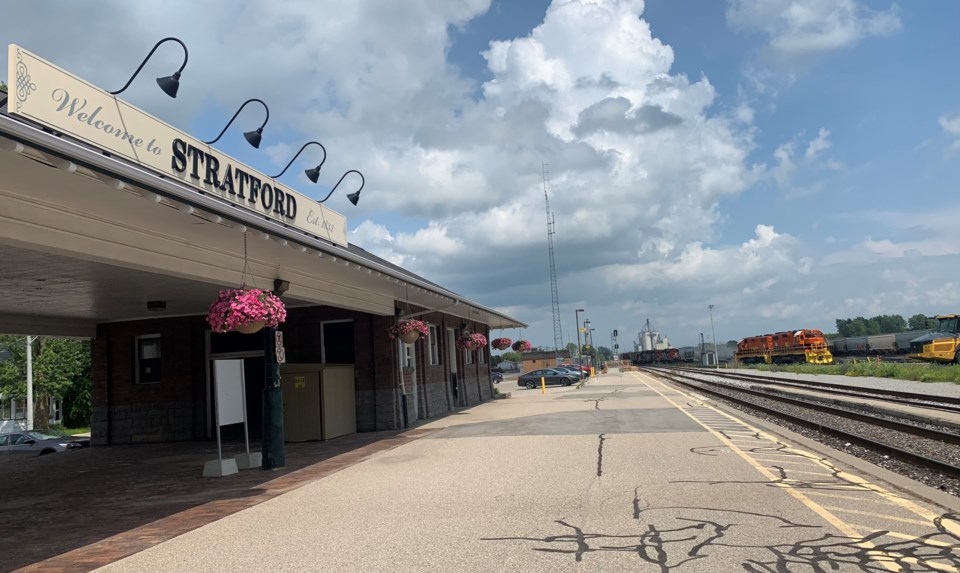Remember your first train ride?
I remember mine, walking in the Chicago train station beside the huge wheels of the locomotive (yes, it was a steam locomotive), and then feeling that gathering chug-chug of the train as it began to move. I was so excited. Today’s trains may not have the drama of those great 'iron horses' of my childhood, but the faces of our family's young folk showed their own excitement on their first trips.
We all know that Stratford’s first claim to fame had nothing to do with theatre, and everything to do with trains.
Stratford’s location enabled two railways to come together in the historic Grand Trunk Railway and Canadian National Railway (CNR) Shops, including a roundhouse and numerous support buildings. Those great hulking buildings behind the 'Y' and our University of Waterloo campus, known as the Cooper Site, once housed great locomotives lifted by gigantic cranes, hoisting the massive engines high overhead for repairs and service.
Imagine the noise, the clank of machinery, the shouted instructions. It was a whole world of its own, a world that supported the city of Stratford for over 80 years.
Part of that early story included a train station.
Not the one we see now, but nevertheless a train station, where passenger trains would pick up Stratford travellers. Dignitaries rode that first train on October 8, 1856, and all of Stratford turned out to greet the train, and a grand ball was held that night. Rail transportation for Stratford had begun. And that was truly a great beginning, as great as the railway yard.
Times have changed. The day of the car dawned. Highways followed, leaping from two lane meandering roads from village to village to multi-lane freeways, cutting across farms and woodland. Progress brought us ever larger vehicles, higher speeds, and...parking fees, traffic jams, and greenhouse gases (GHG). Greenhouse gases are not new. They were a product of volcanoes and natural decomposition of plant matter.
What is new is the industry of fossil fuel that began with the industrial age, and was soon adapted for vehicles in the combustion engine. Within a short time certain gases began to accumulate in the atmosphere. Carbon, methane and nitrous oxide (among others) have formed an envelope around our planet, trapping heat within. The more GHG emissions, the more heat the planet retains.
According to recent statistics, we are rapidly approaching levels of global heat that will become deadly for life on the planet. The vast majority of GHG come from two sectors: oil and gas production and use (28 per cent), and transportation (22 per cent).
A BIG help would be to look at means of transportation beyond highways, for example: trains. The rail industry produces just one per cent of Canada’s greenhouse gas (GHG) emissions, even though it transports more than 100 million passengers and around 70 per cent of the country’s intercity freight each year.
Here in southwestern Ontario, a steadily increasing network of major highways has resulted in a massive increase of cars on the road, often with one driver per car, as well as ever-larger semitrailers.
Navigating highway traffic twice daily has become a white knuckle challenge. The cost of this structure isn’t only in GHG and tension. Across Canada, the total cost of ownership for a car is approximately $1,077 per month when you factor in all your car payments, gas, maintenance, parking and auto insurance costs.
A train ride is a completely different experience. It’s a relax time, a time to doze, have a cup of coffee, and if your train has WiFi, to work (or game/movie) on your laptop, and leave the journey in the hands of the engineer and staff. Trains go regardless of the weather, don’t get stuck in traffic jams, and don’t come with parking fees once you arrive.
Here in Stratford our rail service has been sporadic, and is now on a very fragile lifeline indeed.
In October, we will lose the early morning GO train, and the return train in the afternoon. The loss of GO will leave us with only two trains: VIA train 84 leaves Stratford at 11:16 a.m. and arrives in Toronto at 1:38 p.m. VIA train 87 departs from Toronto at 5:40 p.m. arriving in Stratford at 7:55 p.m. Arriving in Toronto at 1:38 p.m. leaves very little time for any visit, show, medical appointment, or working day. When 84 departed at 8:32 a.m., it was not ideal, but it did allow time in Toronto to do more than turn around and head back again after four or so hours in the big city.
Stratford is an ideal community for young families and people whose jobs take them to Toronto. There is also a highly mobile middle-aged to retired community that greatly enjoys rail access to Toronto. For all these users, trains are infinitely more convenient – and no additional costs for parking. We also have a strong tourism industry, anchored by the Stratford Festival that has been forced to provide buses for visitors from Toronto where once there were trains.
It makes complete sense environmentally in these days of climate crisis to use passenger rail services on rail lines that already exist for Stratford and for other communities on our line, commonly called the North Line. There are two places we can make our voice heard: VIA and GO. Our mantra all along has been to provide frequent, reliable, and affordable rail transportation.
If services come and stay long enough to be counted on for residents, we can return to the rails and leave gridlock behind.
To let VIA know that we would like more trains, and especially a return of the 8:32 train to Toronto, write to [email protected]. To let GO know that you would like a return of the morning commuter train and the train returning in the afternoon, write to [email protected]. Copy MP John Nader and MPP Matthew Rae.
All Aboard!



